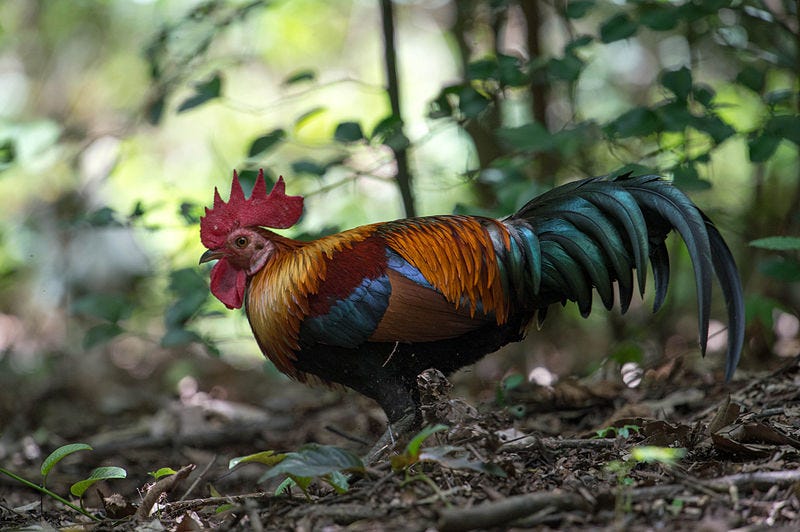How Rice Domesticated the Chicken
The hen first began living alongside humans in a small rice farming community of Thailand 3500 years ago

Have you wondered why chicken pairs well with rice? Why do we find chicken and rice dishes such as biryani, jambalaya, pilaf, and paella comforting?
There might be an evolutionary explanation.
Rice fueled the domestication of chickens by enticing the red junglefowl, the chicken’s ancestor, to live with humans.
In 2022, researchers led by Joris Peters, an anthropologist at LMU Munich, discovered that rice farming played a crucial role in the domestication of the red junglefowl. By evaluating data from 89 countries and 600 archaeological sites, they determined that the first chickens were domesticated in Central Thailand between 1650 and 1250 BC.
The study also found that the expansion of rice farming coincided with the spread of chicken worldwide.
If you look at Peters's proposed dates for chicken domestication, you may wonder why the birds joined our farms so late. Pigs, cows, goats, sheep, and horses were all domesticated long ago. Relatively, chickens are newcomers. Agriculture began after the last Ice Age( around 9500 BC), and chickens should have joined our farms sooner.
Peters and his colleagues examined multiple studies that proposed an earlier domestication date to find the answer. Previous researchers suggested that the bird was domesticated in China or India.
We’ll review some of those theories, but first, let’s learn about the red junglefowl and the challenges scholars face in identifying the precise date of its taming.
Reminder: By choosing a paid membership (just $5 a month or $50 annually), you're helping amplify voices that history books too often overlook. Your support means these stories get the attention they deserve.
You’ll gain access to tons of members-only content👇
Full-length deep dives into untold stories, like this one: no paywalls, no cuts.
The entire archive of extraordinary tales from the Ice Age to the Fall of the Mongol Empire, the hottest archaeological finds, and the appetizing history of food.
Early access to special editions, be the first to dive in.
Join lively discussions in members-only posts and subscriber chats (there’s one at the end of the post!)
The Elusive First Chicken
The chicken (Gallus gallus domesticus) descends from the red junglefowl (Gallus gallus) found in the forests of India, Sri Lanka, Southern China, and Southeast Asia.
In 2020, evolutionary biologists led by Ming-Shan Wang from the University of California, Santa Cruz, studied 863 genomes from chicken breeds worldwide, as well as four junglefowl species and five red junglefowl subspecies.
They discovered Gallus gallus spadiceus, a red junglefowl subspecies native to Northeast India, Southeast Asia, and Southern China, was the modern chicken’s ancestor.
As the birds made their way across Southeast and South Asia, domestic chickens mated with different red junglefowl and other junglefowl species( such as the grey junglefowl and Ceylon junglefowl), giving rise to new chicken breeds.
Wang’s comprehensive study helped us identify which subspecies of the red junglefowl the chicken descended from. This provided Peters and his team with clues about where and when chickens began living alongside humans.
Many scholars from the twentieth century proposed that chicken domestication occurred in Northern China or the Indus Valley Civilization. We’ll review their works, but first, we should remember an essential fact about analyzing prehistoric chickens.
Archaeologists determine the age of chicken bones depending on the archaeological stratum in which they are discovered. If a site has been populated for centuries, if not millennia, the layer containing animal remains provides information about the people who lived there during that period.
However, dating chicken bones poses a significant challenge since they are light and can travel through archaeological layers. Chicken bones from later periods appear in previous levels, making it difficult to determine their origin. In archaeology, such bones are referred to as “intrusive.”
Peters and his colleagues accounted for the possibility of intrusive bones as they reviewed the hypotheses for an earlier date of chicken domestication.
Keep reading with a 7-day free trial
Subscribe to Forgotten Footprints to keep reading this post and get 7 days of free access to the full post archives.


